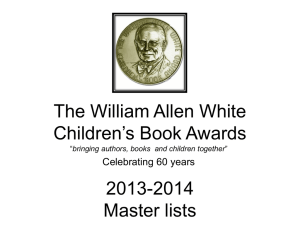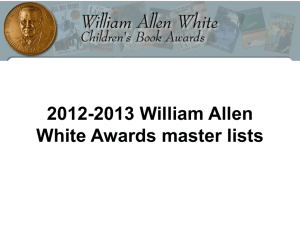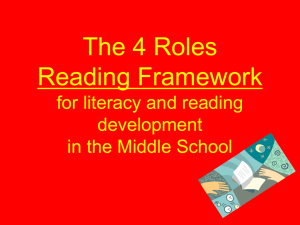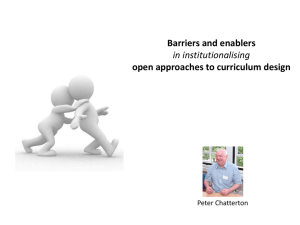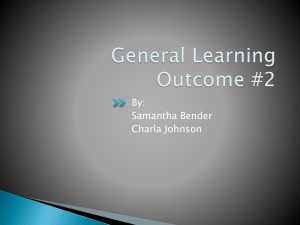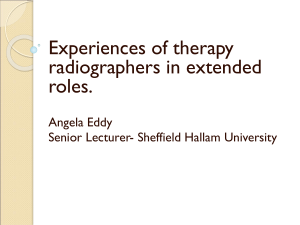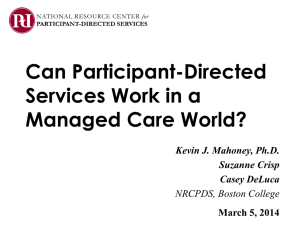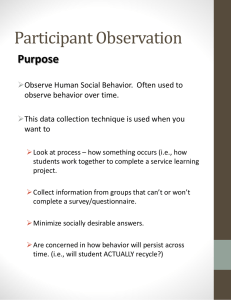Me, Myself & I: Strengthening the professional identities of arts
advertisement
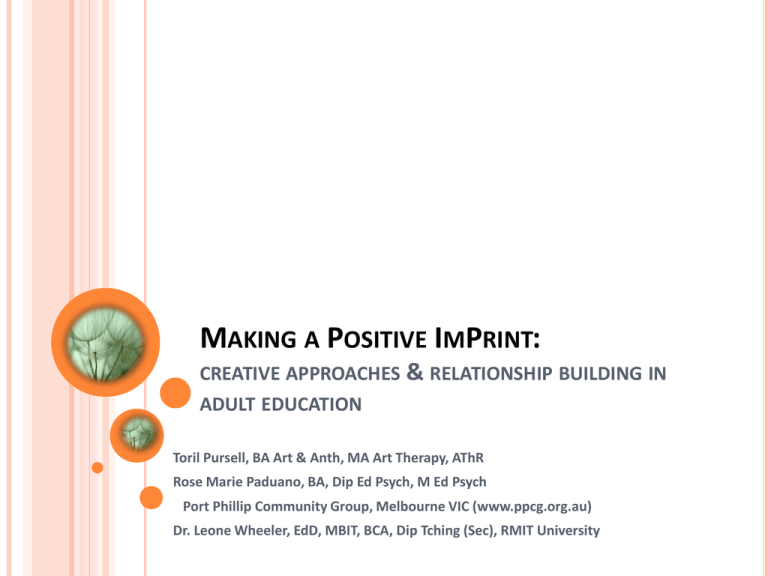
MAKING A POSITIVE IMPRINT: CREATIVE APPROACHES & RELATIONSHIP BUILDING IN ADULT EDUCATION Toril Pursell, BA Art & Anth, MA Art Therapy, AThR Rose Marie Paduano, BA, Dip Ed Psych, M Ed Psych Port Phillip Community Group, Melbourne VIC (www.ppcg.org.au) Dr. Leone Wheeler, EdD, MBIT, BCA, Dip Tching (Sec), RMIT University WORKSHOP STRUCTURE Introduction: RMIT and ImPrint context report ImPrint team roles and a relationship focussed learning framework Reaching the ‘hard to reach’ learners- promotion, referral and evaluation methods Enablers and barriers to learner engagement Curriculum and creative approaches to adult education Participants and building relationships Conclusion INTRODUCTORY ACTIVITY Each person select up to 2 cards that relate to working with “hard to reach” adult learners What makes some a “hard to reach” learner? What is the first enabler or barrier that comes to mind? In pairs share which cards you chose and why. Write down key words and/ or questions. RMIT CONTEXT REPORT Literature Review Who are the “hard to reach”? Going beyond labels Practical strategies Case Studies Interviews Recommendations for next phase of project RMIT CONTEXT REPORT ADULT EDUCATION FOR MARGINALISED LEARNERS: PATHWAYS OR PLATEAUS? (GLAMORGAN AND KELLY) A RELATIONSHIP FOCUSSED LEARNING FRAMEWORK IMPRINT TEAM ROLES Group Facilitator (GF) Develop ‘alternative’ curriculum with A-Frame & participant feedback Facilitate weekly group workshops & excursions to engage ‘hard to reach’ learnersmake non-formal learning fun Address questions, conflicts and concerns within group Collaborate and share information with Support Mentor Document & evaluate process Support Mentor (SM) Locate and select ImPrint participants Provide regular individual support via meetings and telephone Encourage course retention by identifying enablers and barriers to course participation Resolve conflicts between participants and address concerns about curriculum Develop pathways on completion of ImPrint ‘Modelling a positive working relationship’ IMPRINT: HOW IT WORKS Promotion Referral process Evaluation methods PARTICIPANT BACKGROUND & SELF-REPORTING Majority of participants were middle-aged males in single household Most were on DSP or equivalent Reasons for joining ImPrint were generally out of interest or ‘something to do’ Extremely varied literacy levels, learning styles and interests (age mid-20’s to early-70’s, culturally diverse) ACFE self-reporting pros and cons Retention rates between Block I and Block II ENABLERS & BARRIERS TO ENGAGEMENT Enablers: Life experience, group dynamic, Support Mentor and incentives Barriers: Anxiety, fear, addiction, mental health challenges, socio-economic status and negative learning experiences Prolonged isolation and lack of exposure to social groups CURRICULUM Input/ Relevance Social component & normalising Practice & application Feedback & sharing Professional care CREATIVE APPROACHES TO ADULT EDUCATION PROCESS & OUTCOMES OF IMPRINT EXHIBITION PARTICIPANTS AND BUILDING RELATIONSHIPS Then Now Participant A: Looking for mentoring, unhappy social life and confident in groups Participant A: Computer training neighbourhood house, counselling, art group, designing small business plan and job applications Participant B: Depression, alcoholism, ABI and other health problems Participant C: Chronic mental health issues, PTSD, lack of social contact Participant D: General mental health difficulties, limited social contact, language barriers Participant B: Our Voices steering committee, computer training, swimming, Photoshop session Participant C: Art program, mental health intervention Participant D: Kitchen work, English, counselling, driving program, assisting with church duties THE VOICE OF PARTICIPANTS The benefit of having Rose there was that Rose is a person that has been able to diffuse conflict during the week before the participants got to the group session with Toril. It enabled Toril to remain impartial. The development of social skills, increasing confidence and the importance of group acceptance ….. translated to everything I do and I consider it the basic building block of life. I actually set a whole lot of goals and set targets and all sorts of stuff. So I did a huge, what do you call it, 10-page plan. I tick things off and I did the, what do you call it, the eight-week check-up today. I can see I've really progressed and I've done so much more than what I actually thought so I'm getting work up and running, I've really increased in confidence, brilliant. Brilliant, brilliant. The fact that I can keep going and do follow-ups with Rose is just fabulous. IMPRINT: CONCLUSION Re-considering the definition “hard to reach” A new ACFE model with Support Mentor & positive relationships Transparency and communication Co-facilitating to ensure needs are met The importance of adequate planning, clear purpose, and learner input The power of a shared meal, incentives and the politics of language Longer-term pilot programs w/ emphasis on transition phase before ‘pathways’ Engaging support services (linking in) Creative approaches and building relationships = a rehearsal ground REFERENCES Ahern, S. 2011. Social Meals Program A Qualitative Analysis: A Comprehensive Report and Recommendations for the Social Meals in Rooming House Program in the City of Port Phillip, Melbourne. St Kilda Community Housing Ltd. [Online]. Available: http://www.stkch.org.au/wpcontent/uploads/SMP-a-qualitative-analysis.pdf [Accessed 4th May 2012] Brackertz, N. 2007. Institute for Social Research working paper: Who is hard to reach and why? Melbourne: Swinburne University of Technology. Nechvoglod, L. & Beddie, F. 2010. Hard to reach learners: What works in reaching and keeping them? Melbourne: NCVER. Neef, M. A. 1991. Human Scale Development - Conception, Application and Further Reflections. New York and London: The Apex Press. McGivney, V. 1999. Informal learning in the community: a trigger for change and development, Leicester National Institute of Adult Continuing Education, NIACE.


